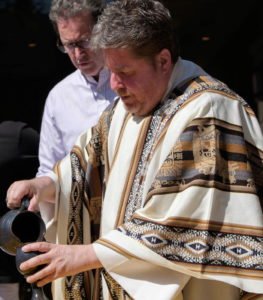 In a sermon preached 1600 years ago, give or take, St. Augustine of Hippo pointed to the bread on the altar and said, “We call that the body of Christ.” He then gestured toward the congregation: “Yet the Apostle Paul calls you the body of Christ. So it is your own mystery that you see on the table. It is your own mystery you receive when you come forward. When you take the bread in your hands and answer ‘Amen’ to the words, ‘The body of Christ,’ you say amen to what you are. So,” he exhorted, “live as Christ’s body that your ‘amen’ may be true.” (Sermon 272)
In a sermon preached 1600 years ago, give or take, St. Augustine of Hippo pointed to the bread on the altar and said, “We call that the body of Christ.” He then gestured toward the congregation: “Yet the Apostle Paul calls you the body of Christ. So it is your own mystery that you see on the table. It is your own mystery you receive when you come forward. When you take the bread in your hands and answer ‘Amen’ to the words, ‘The body of Christ,’ you say amen to what you are. So,” he exhorted, “live as Christ’s body that your ‘amen’ may be true.” (Sermon 272)
That seems like a radical identification between the church and the one whom we name as Lord and Saviour, to be sure. Yet Augustine’s insight is very biblical. After all, as the good bishop noted, Saint Paul makes the same claim in the many ways he refers to the church as the body of Christ.
Augustine’s proclamation continues to echo a crucial insight into our own time and context: the body of Christ is not only on the table; it is also around the table.
We need to underline these as words of tremendous relevance for mission and congregational vitality today. Just as the risen Christ is made known to the disciples in the bread that is his body on the table, so the risen Christ is made known to those beyond our walls in the people that are his body in the world.
I have an icon, as well as many other captivating pictures, depicting the story of the encounter on the road to Emmaus (Luke 24.13-35), the reel that spins on our lectionary projector every three years on the Third Sunday of Easter and annually during the evening of Easter’s First Sunday. I spend a fair bit of my prayer time gazing at these images throughout the year: despairing disciples heading the wrong way; the stranger who comes and listens to them and “meets them where they are”; the proclamation that causes their hearts to burn within them in a way that prepares them to see; the hospitality offered and accepted that leads to bread broken and Saviour recognized; two once despairing disciples going out as a living testimony to the risen Christ!
My prayerful immersion in this story has persuaded me that it is not enough to identify only with the two disciples on the Emmaus road. There is a larger vision and vocation to embrace: another character with whom it is imperative for us to identify.
The faithful and vital church, you see, is that stranger saddling up alongside people in despair, conflict, or confusion, listening to them and walking with them—meeting them where they are. We are Christ’s ears and his compassionate presence.
The faithful and vital church is the company of people that responds by not only telling the story, but also by actually being the Story of the risen One, kindling hearts and sparking imaginations.
The faithful and vital church is bread—taken, blessed, broken, and shared—through which the Lord Jesus is revealed and recognized.
The faithful and vital church is the inspiration for others to join in the acclamation: “We have seen the Lord! Alleluia!”
The refrain for one of my favourite songs sings these words:
“Let us be bread blest by the Lord,
broken and shared, life for the world.
Let us be wine, love freely poured.
Let us be one in the Lord.”
Just as the risen Christ is made known to the disciples in the bread that is his body offered on the table of the church, so the risen Christ is made known to those beyond our walls in the people that are his body offered on the table of the world. Moreover, if we are paying attention, we will not only recognize Christ in the breaking of the bread: we will see Christ, too, in the faces of those whom we serve.
So let the church say, “Amen,” and may our ‘amen’ ring true!

By Kyn Barker April 28, 2017 - 10:14 am
My sermon for Sunday was coming together pretty well but seemed to be missing something, which was just hidden…(where to see Jesus)….until I read the post!
By John Cathcart April 28, 2017 - 12:52 pm
Thank you for this. Very insightful and inspired. Particularly like the connection between bread as thr body of Christ and we, the church as the body of Christ. Thanks again and blessings on your preaching.
By Father Ron Smith April 28, 2017 - 8:20 pm
Spot on, Father!
As Jesus was recognised by the two disciples – not by his physical appearance, but by his characteristic ‘Breaking of The Bread’, so we, in the Body of Christ, both recognise and became the Body of Christ at the Eucharist. Christ is Risen, Alleluia! He is Risen indeed, Alleluia, Alleluia!